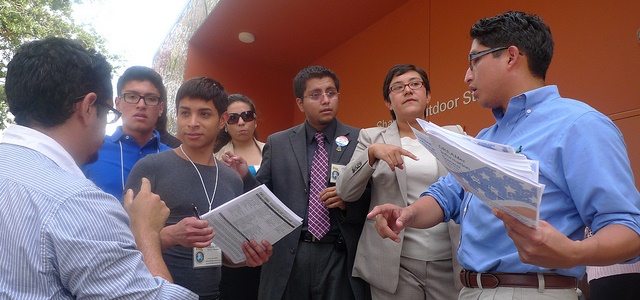 The latest USCIS DACA numbers from March show that the agency has received roughly 470,000 applications, which means that just under half of those estimated to be eligible have applied. While the success reflected by the 470,000 figure is not to be downplayed, the new numbers beg the question: What about the other half million? Why are they still unDACAmented?
The latest USCIS DACA numbers from March show that the agency has received roughly 470,000 applications, which means that just under half of those estimated to be eligible have applied. While the success reflected by the 470,000 figure is not to be downplayed, the new numbers beg the question: What about the other half million? Why are they still unDACAmented?
Hard data isn’t available yet, but the organizations working tirelessly to help young people apply for DACA believe that a large percentage of eligible immigrants are living in rural America, which presents them with a range of challenges. Estimates show that roughly one quarter of all DREAMers live in rural communities and that upwards of half of them need to enroll in a qualifying adult education program to become DACA-eligible. If we hone in on the migrant farmworker population — which contains about 55,000 DREAMers – over 80% would need to take steps to meet the education requirement.
Apart from the educational hurdle, there is a substantial financial one. Migrant farmworkers generally earn a little over $11,000 a year, making the $465 DACA filing fee cost-prohibitive. As if these obstacles weren’t enough, itinerant farmworkers are particularly hard-pressed when it comes to producing evidence of continuous residence since June 15, 2007 (a requirement of the program) and gaining access to legal services.
Anecdotal evidence bolsters these conclusions. Recently, the Florida Dream Coalition, working in conjunction with volunteer law students from the University of Miami and Florida International University, organized several DACA workshops throughout central Florida. During the workshops, immigrants described the obstacles they faced to applying for DACA. Those living in rural communities provided consistent answers: they didn’t know about the program; they live far away from legal service providers; they fear that the government will try to deport them if they apply; they don’t meet the education requirement; and, above all, the application fee is too high. At the Gainesville DACA clinic, the Harvest of Hope Foundation, a non-profit providing migrant farmworkers with emergency and education services, pledged funds to cover the filing fees of local DACA applicants. Nearly every individual at the clinic that day needed financial assistance.
Lessons from North Carolina lend credence to the theory that there is an urban/rural divide within the applicant pool. If you compare USCIS figures to estimates produced by the Immigration Policy Center, it turns out that about 40-50% of the eligible DREAMer population has applied for DACA. Except in North Carolina. In North Carolina, roughly 16,500 out of an estimated 18,000 — 90% — have applied. What explains the disparity? Farmworker organizers report that North Carolina’s farmworker outreach network is exceptional. In which case, North Carolina may provide the model for effective DACA implementation throughout the country.
If indeed many of the remaining unDACAmented youth are in rural America, future outreach efforts must be targeted accordingly, placing appropriate emphasis on linking would-be applicants to qualifying adult education programs. It also means that the availability and accessibility of microloans and scholarships for DACA filing fees will play a make-or-break role for tens of thousands of individuals going forward.
Let’s not miss the silver-lining, however. If this hypothesis is correct, then outreach in urban areas has largely been a success. The impassioned, outspoken and social media-savvy DREAMers at organizations like United We Dream and its affiliates deserve immense credit for getting the word out about DACA. Half a million applications in 8 months is no small feat. Now it’s time to turn our attention to the rural areas and getting those young people DACAmented.
Photo by Neighborhood Centers
FILED UNDER: Children, DACA, Deferred Action, Executive Branch, Students, undocumented immigration


